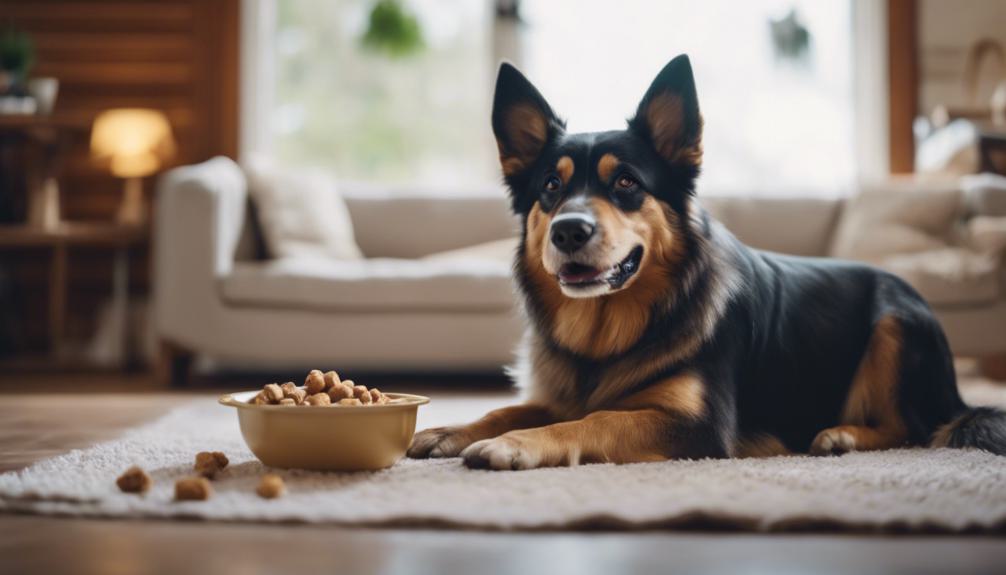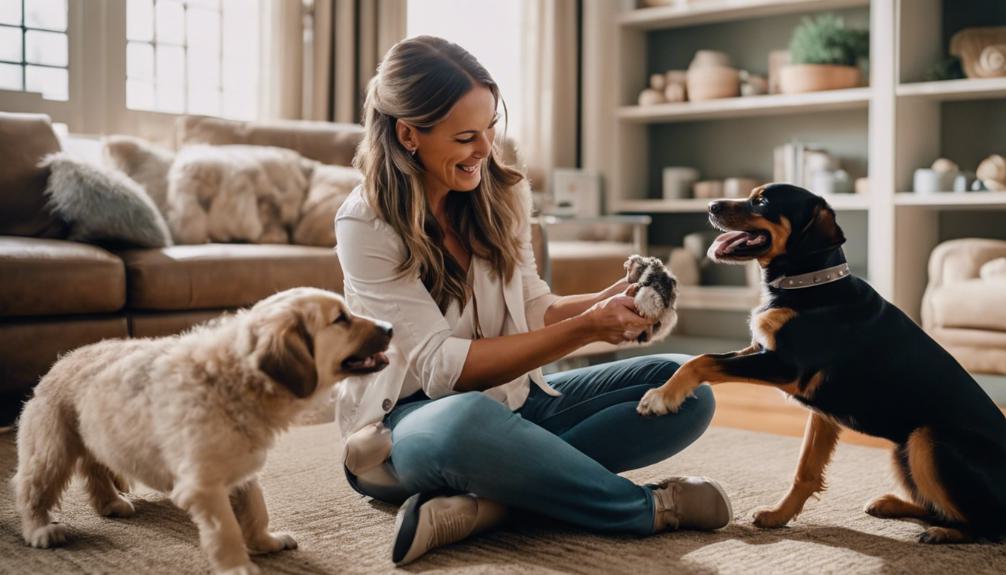How to Train Your Dog Around Babies? Baby-Friendly Training
To train your dog around babies, start with positive reinforcement. Teach basic commands and desensitize to baby sounds. Be consistent and begin training early. Implement obedience commands in various settings and create a safe environment. Set clear boundaries, use baby gates, and supervise interactions closely. Address challenges proactively and seek professional help if needed. Foster positive associations through games and gentle interactions. Encourage cooperation and mutual comprehension through shared experiences. Maintain routines and reinforce good behavior. Strengthen bonds with regular training. For more detailed guidance on training your dog around babies, explore the early training foundations and positive reinforcement techniques mentioned.
Establishing Early Training Foundations
To establish a solid foundation for training your dog around babies, initiate the process with positive reinforcement techniques such as treats and praise. Teach your dog essential commands including ‘sit’, ‘stay’, and ‘leave it’ to promote desired behaviors. Incorporate desensitization to baby sounds into your training sessions to prepare your dog for real-life scenarios. Maintain consistency in your training efforts to ensure your dog behaves appropriately around babies. Start these training methods early to build a robust foundation.
Here are some practical tips for each step:
- Use Positive Reinforcement: Reward your dog with treats and verbal praise to encourage good behavior. This method is scientifically proven to be effective in animal training.
- Teach Basic Commands: Commands like ‘sit’, ‘stay’, and ‘leave it’ are crucial. They help in managing your dog’s behavior, especially in potentially chaotic situations.
- Desensitize to Baby Sounds: Play recordings of baby noises during training sessions to acclimate your dog to these new sounds. Over time, this can help reduce anxiety or overexcitement when your dog hears these sounds in reality.
- Consistency is Key: Consistency in training commands and routines helps your dog understand what’s expected, leading to better adherence to behaviors.
- Start Early: Beginning training early in your dog’s life sets a precedent for lifelong learning and adaptability.
Implementing Basic Obedience Commands
To train your dog around babies, focus on basic commands such as ‘sit,’ ‘stay,’ and ‘leave it.’ Consistency in training reinforces these commands and helps control your dog’s behavior. Practice these cues in different settings to ensure your dog’s obedience in any situation. Use positive reinforcement, like treats and praise, to encourage your dog’s compliance. This approach fosters a safe and peaceful environment for both your dog and the babies.
Start with the ‘sit’ command, which is fundamental for managing your dog’s impulsiveness. Next, teach ‘stay’ to keep your dog calm and stationary when needed. Introduce ‘leave it’ to prevent your dog from picking up unwanted items or getting too close to the baby. Regular practice helps your dog understand and follow these commands reliably.
Utilizing Positive Reinforcement Techniques

To shape your dog’s behavior around babies, reward them with treats, praise, or toys when they act calmly and gently. This method, known as positive reinforcement, helps dogs associate good behavior with pleasant outcomes. Regular rewards reinforce these behaviors, making it clear what you expect from your dog.
Over time, your dog will learn to consistently behave well around the new family member. Keep the rewards consistent and tailor them to what your dog loves most, whether that’s a special snack or a favorite toy. This strategy not only improves behavior but also strengthens the bond between you and your pet.
Creating Safe Interaction Spaces
To ensure the safety of both your dog and baby, set up clear boundaries using baby gates, playpens, and specific sleep areas. Train your dog to respect these boundaries by associating them positively with areas like dog pens or crates. When walking your dog near the baby, always use a leash and harness to maintain control and safety. These measures can help prevent separation anxiety and foster a peaceful environment where both your dog and baby can thrive.
Supervising Dog-Baby Interactions Closely

When supervising your dog and baby together, always use baby monitors and pet cams to keep a close watch. Observe your dog for signs of discomfort, such as hesitation or tension, which might indicate stress or fear. Always maintain direct supervision to quickly address any potential issues. Pay attention to your dog’s body language to spot any stress cues when they are around the baby. Be alert for any signs of aggression or unease during their interactions.
| Supervision Tips | Description |
|---|---|
| Baby monitors | Allow continuous observation. |
| Pet cams | Facilitate real-time monitoring. |
| Signs of discomfort | Watch for hesitation or tension in the dog. |
| Direct supervision | Essential to intervene if necessary. |
| Body language | Key to recognizing stress cues. |
Addressing Behavior Challenges Proactively
To handle behavior challenges proactively with your dog around babies, start with early training and maintain consistent routines. Address issues such as leash reactivity or resource guarding before the baby arrives to avoid future problems. Set clear boundaries for your dog when interacting with infants. If needed, seek help from certified dog trainers who specialize in positive reinforcement techniques.
Remember, tackling these challenges early ensures a safer environment for both your baby and your dog. Using simple, direct training methods helps your dog understand what’s expected. For example, teaching your dog to sit or stay calmly near the baby can be beneficial. Consistency in these routines reinforces good behavior.
Also, introducing your dog to baby-related noises and smells before the baby comes home can reduce stress and confusion. This can include playing recordings of a baby crying or letting the dog sniff baby lotions and powders.
If problems persist, consulting with a professional trainer can provide tailored solutions. They can offer strategies that address specific issues your dog might have, ensuring that interactions with your baby are safe and positive.
Seeking Professional Training Support

To handle behavior challenges and improve the bond between your dog and your baby, consider professional training support. A certified dog trainer who specializes in new family dynamics can be very helpful. They work on key areas such as behavior correction, creating positive interactions, and teaching obedience. Their approach includes setting clear boundaries, managing how your dog and baby interact, and maintaining a safe space for both. This support can lead to a peaceful home environment.
Seeking help from a professional ensures that they use proven methods to address any issues. Trainers often rely on techniques supported by animal behavior research, which suggests that positive reinforcement is effective in training dogs. By consistently rewarding good behavior, trainers teach dogs to repeat those actions, particularly important in households with young children.
Fostering Positive Associations and Bonding
To create strong connections between your dog and baby, employ positive reinforcement like treats and praise. Use interactive games to build favorable associations. Encourage gentle interactions to foster understanding and respect. Always supervise these moments to ensure safety and positive outcomes. Include joint training sessions for your dog and baby to enhance their bond.
Remember to use easy-to-understand commands and rewards when guiding your dog’s behavior around your baby. This approach aligns with established training methods that highlight consistency and clarity, as noted in animal behavior research. Positive reinforcement not only aids in training but also helps in forming a bond based on trust and mutual respect, as explained by experts in canine psychology.
Ensure all interactions are monitored to prevent any accidental harm. According to safety guidelines from pediatric associations, close supervision during early interactions between pets and children is crucial for preventing misunderstandings and injuries.
Next, involve both your dog and baby in activities that require them to cooperate or participate simultaneously. This could be as simple as having your baby feed your dog under supervision, or having your dog sit calmly as your baby plays nearby. Such activities help both learn about each other’s presence and behaviors, fostering a mutual bond.
Also, keep sessions short and enjoyable. Long training or interaction periods can tire both your baby and dog, leading to frustration or disinterest. Short, positive experiences build a better foundation for their relationship.
Maintaining Consistent Routine and Boundaries

To effectively manage your dog’s behavior around babies, establishing consistent routines and clear boundaries is crucial.
- Create Stability with Routines: Set specific times for feeding, walking, and playtime. This regular schedule helps your dog know what to expect each day, reducing anxiety and improving behavior.
- Enforce Rules Consistently: Maintain clear boundaries. If you don’t allow jumping on furniture, apply this rule at all times. Consistency helps your dog understand what’s expected, making it easier for them to follow rules.
- Reinforce Good Behavior: Use treats and praise to reward your dog when they behave well around babies. Positive reinforcement is a proven method to encourage desirable behavior, as supported by studies in animal behavior.
- Strengthen Bonds Through Training: Hold regular training sessions. These not only teach your dog obedience but also deepen the connection between you and your pet. Practicing commands like ‘sit,’ ‘stay,’ and ‘leave it’ can be particularly useful in managing interactions with babies.
Frequently Asked Questions
How Do I Train My Dog to Be Gentle Around My Baby?
Teach your dog gentle commands like ‘be soft’ and reward calm behavior. Supervise interactions, set boundaries, and redirect rough play. Give mental and physical exercise to reduce excitement. Consistency and positive reinforcement will help your dog be gentle around your baby.
How Long Does It Take for a Dog to Adjust to a New Baby?
Adjusting to a new baby varies for dogs; it can take days to months based on the dog’s temperament and past experiences. Older dogs might need more time. Consistent training, supervision, and positive interactions can speed up the process.
How Do I Train My Dog to Protect My Baby?
Show your dog that the baby is part of the pack by modeling gentle interactions. Encourage protective instincts through positive reinforcement. Train your dog to alert you to any potential dangers while respecting boundaries to guarantee a safe and harmonious environment.
What if My Dog Gets Too Excited Around Babies?
If your dog gets too excited around babies, create calm activities like walking. Slowly expose them to baby sounds. Offer a safe retreat space. Reward calm behavior and seek help from a trainer if needed.
Conclusion
To train your dog around babies, start with patience, consistency, and positive reinforcement. Begin with basic training commands early.
Make sure to create safe areas where your dog and baby can interact under close supervision. Always monitor their interactions to prevent any issues.
If your dog shows challenging behaviors, address these immediately. Don’t hesitate to get help from a professional trainer if needed.
With the right training, your dog and baby can safely and peacefully share your home.

